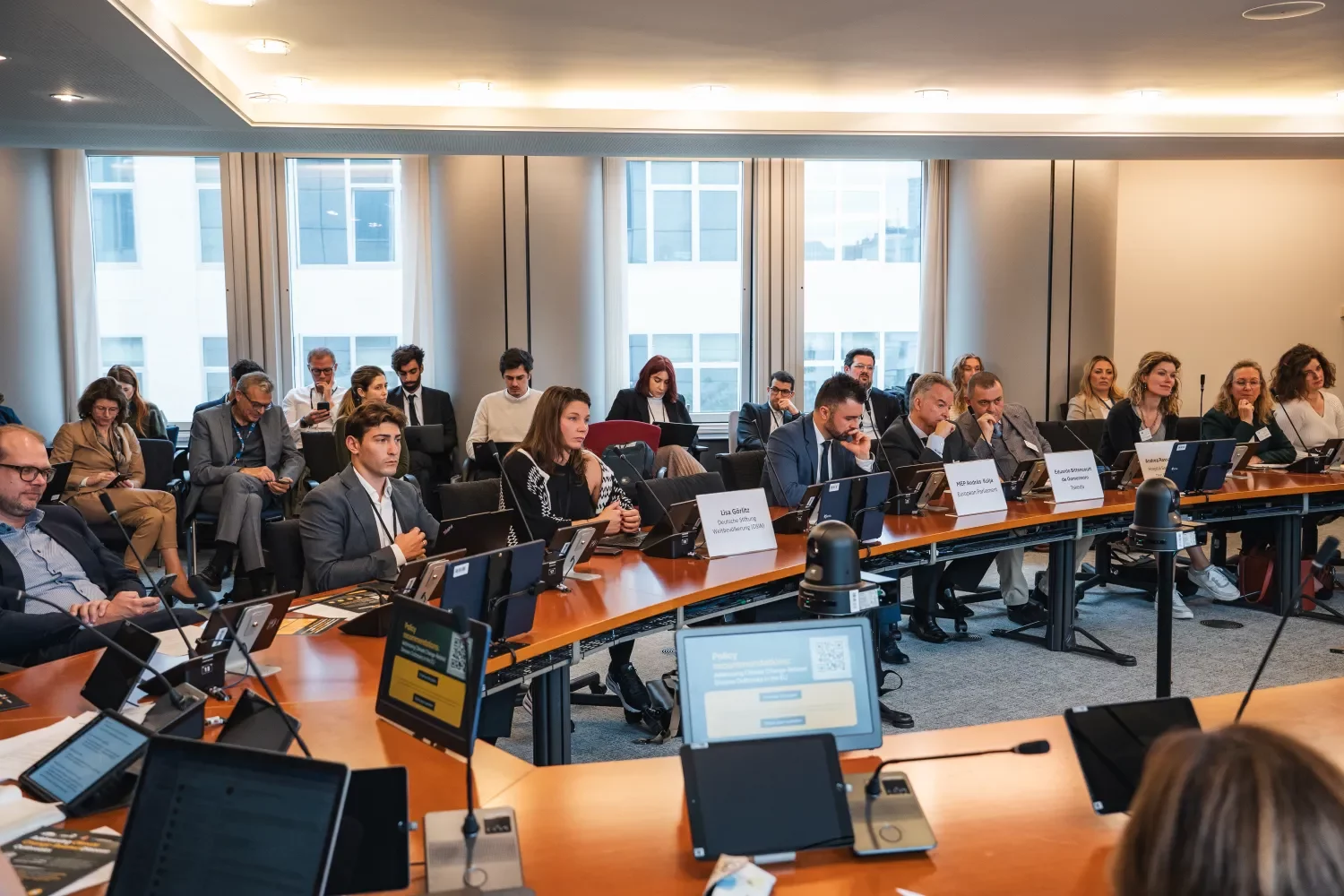Policy recommendations:
Addressing Climate Change-Related Disease Outbreaks in the EU
Mosquito-borne diseases such as dengue, chikungunya, and West Nile Fever are on the rise in Europe—and climate change is driving the spread.
About
Climate change is accelerating the spread and severity of mosquito-borne diseases across Europe. Warming temperatures and increased rainfall create ideal conditions for mosquitoes and other disease-carrying vectors to thrive and expand into new regions. As a result, outbreaks of diseases such as dengue, chikungunya, Zika, and West Nile virus are now reported to occur in areas where they were previously rare or absent. These outbreaks may carry the risk of becoming endemic or even pandemic, have been observed in some places to be extremely difficult to control once established, and can pose serious threats to vulnerable populations.
Enhancing health, security and preparedness against the risk of mosquito-borne climate-related disease outbreaks requires the EU and its Member States to urgently:
Advanced Warning
Enhance surveillance and epidemiological capabilities, within the EU and globally, to provide early identification of local outbreaks.
Increased Preparation
Adequately prepare for outbreaks by stockpiling essential countermeasures, such as vaccines, and establishing efficient distribution mechanisms to ensure rapid access.
Proper Communication
Urging national immunization advisory groups (NITAGs) to issue recommendations for vaccination, in advance of outbreaks.
Adequate Funding
Increase investments in research, preparedness, and collaborative initiatives to mitigate risks and protect public health, in line with the EU’s competitiveness agenda.
Encourage Collaboration
Build cross-border resilience as part of the EU Preparedness Union Strategy.
Increased Alert Level
Encourage DG HERA and ECDC to include climate change-related diseases among their priority health threats.
Impact
Climate change, according to the World Health Organization (WHO), may be the defining global public health threat of the 21st century
Looking ahead, climate-driven mosquito-borne disease outbreaks could seriously strain public health, with rising illness and death rates. Vulnerable groups – children, the elderly, pregnant individuals, and those with chronic conditions – are hit hardest. This growing burden risks deepening global inequalities, especially in LMICs, and may spark new disparities within Europe, particularly in southern and rural areas.
Continental Europe has already seen cases of mosquito-borne arboviral diseases. The Lancet Planetary Health study ‘Impact of climate and Aedes albopictus establishment on dengue and chikungunya outbreaks in Europe: a time-to-event analysis’ documents how the tiger mosquito, native to southeast Asia, is now established in a majority of European countries.
On June 11th, 2024 ECDC issued a warning about the increasing number of cases of locally transmitted dengue in Europe, due to climate change and the spread of competent mosquito vectors.
Dengue virus
130 locally reported in 2024
71 cases in 2010 to 2021
130 locally reported in 2024
71 cases in 2010 to 2021
West Nile virus
713 locally acquired cases and 67 deaths in nine EU countries in 2023
1.133 locally acquired cases in 2022
Find out more about impact in the paper
Partners
A new policy paper co-authored by pharmaceutical companies Valneva and Takeda, with the support of Deutsche Stiftung Weltbevölkerung (DSW) and the International Society for Neglected Tropical Diseases (ISNTD), aims to raise awareness about the growing threat of mosquito-borne diseases in Europe due to climate change. The paper presents concrete policy recommendations for the EU institutions, agencies, and Member States to strengthen disease surveillance, stockpile essential countermeasures, and boost vaccination preparedness. These recommendations will be officially launched at the European Parliament on 25 September 2025, during an event hosted by MEP Andras Kulja.
Recommendations
Policy recommendations to enhance health security and preparedness
Enhance surveillance and epidemiological capabilities, within the EU and globally, to provide early identification of local outbreaks.
Policymakers must prioritise addressing climate change-related mosquito-borne diseases: they have the potential to spread quickly to Europe through global trade and travel which enable migration of disease vectors or the diseases themselves.
The success of the EU’s Preparedness, Medical Countermeasures, and Stockpiling Strategies is closely linked with comprehensive early detection.
The European Environment and Epidemiology Network and VectorNet – key tools established by the European Centre for Disease Prevention and Control (ECDC) – should be expanded and strengthened with international reach to enhance EU and global capabilities to protect citizens.
Reporting guidelines across Europe must be consolidated, ensuring consistent national and EU-wide tracking of arboviral diseases like dengue, chikungunya, and Zika.
Regular scientific exchange between ECDC and industry is essential to build a robust data foundation and enable rapid, coordinated responses to emerging threats.
Beyond specific measures targeting mosquito-borne diseases, it is imperative for the EU and Member States to actively facilitate and fund comprehensive capacity-building initiatives worldwide.
ECDC should strengthen collaboration with global Centres for Disease Control (CDCs), focusing on aligning practices and controls.
The EU and Member States must prioritise tools for detection and surveillance, especially in partnership with authorities from Third Countries.
Efforts should target enhanced diagnostics and robust reporting systems, enabling early identification and response to epidemic threats.
Improved global coordination will boost preparedness and accelerate responses to mosquito-borne disease outbreaks.

Encourage EU Member States to adequately prepare for outbreaks by stockpiling essential countermeasures, such as vaccines, and establishing efficient distribution mechanisms to ensure rapid access
COVID-19 showed the power of fast vaccine deployment to control outbreaks and restore normalcy. For mosquito-borne diseases, we need a dual approach: targeted vaccination programmes and strong community-based interventions to reduce impact.

Effective disease control requires a One Health approach, integrating human, animal, and environmental factors.
Rapid vaccine deployment depends on availability—yet production cycles often exceed 12 months, and travellers’ vaccines are scarce on the private market.
Stockpiling should be considered to ensure doses are ready at short notice during outbreaks.
Vaccine procurement and rollout often rely on national recommendations, which can delay response.
National Immunisation Technical Advisory Groups (NITAGs) should lead in issuing proactive, harmonised vaccine guidance across the EU—before outbreaks occur.
EU strategies on preparedness, stockpiling, and countermeasures must reflect the unique challenges of mosquito-borne disease countermeasures. Few licensed vaccines exist, and most are still in early development.
- Even available vaccines lack consistent recommendations and uptake—this gap must be addressed to ensure readiness.
- Policymakers should support vaccine development and uptake, backed by real-world evidence, through increased funding and strong incentives.
- The goal: proven efficacy and scalable manufacturing, enabling rapid stockpiling or production during emergencies.
- Example: Italy’s SIMVIM issued dengue vaccine guidance, which was adopted by three regions—Lazio, Lombardy, and Romagna—for both travellers and residents.
Looking ahead, the future EU Climate Adaptation Plan should become a priority and consider the risk to Europe from the increasing presence of vectors and local cases of emerging mosquito-borne diseases.

Increase investment in research, preparedness, and collaborative initiatives to mitigate risks and protect public health, in line with the EU’s competitiveness agenda.
COVID-19 was a wakeup call: infectious diseases are cross-border threats that can devastate lives, economies, and infrastructure. Investment in preparedness and response against mosquito-borne threats should be treated by the EU on the same priority level as defense.
Public investment is critical to develop, procure, and stockpile countermeasures for climate-driven mosquito-borne diseases.
Proven COVID-era platforms—like viral vectors, RNA, and inactivated virus technologies—should be leveraged for rapid vaccine scale-up.
Innovative platforms must be funded, creating a flexible “toolbox” for future threats.
Focus areas include thermostable and needle-free vaccines to enable faster, self-administered deployment—especially in regions lacking cold-chain infrastructure.
Equitable response requires inclusive clinical trials, with pregnant and lactating populations represented, in line with WHO’s 2024 guidance.

The pharmaceutical and biotech industry has demonstrated a capacity to develop, manufacture and deliver vaccines at large scale and volumes. However, since industry cannot define threats alone, close co-operation with EU agencies, institutions and governments is necessary to ensure a timely response. HERA should be encouraged to foster strong collaborative relationships with the global vaccines industry while supporting vaccine equity globally.
To ensure readiness for emerging threats, speeding up development of essential medical countermeasures is key.
Advance Purchase Agreements (APAs) during COVID-19 showed how public-private cooperation can accelerate vaccine development—EU guarantees enabled industry action even before authorisation.
This model should be replicated to drive vaccine innovation for climate-linked mosquito-borne diseases.
The EU must explore additional pull incentives, complementing existing push funding like Horizon Europe and European and Developing Countries Clinical Trials Partnership (EDCTP).
The EU Biotech Act and the Life Sciences Strategy should strengthen R&D and resilient supply chains, ensuring Europe is prepared for future health threats.
Most vaccine facilities in Europe are product-specific, lacking the flexibility to quickly scale up production for new countermeasures during emergencies.
This manufacturing gap delays timely vaccine deployment, highlighting the need for more adaptable production capabilities across the region.
Governments should partner with industry to tap into flexible manufacturing and ensure surge capacity.
Public-private partnerships can support stockpiling and rapid production of countermeasures when needed.

Call for initiative-taking measures and strategic planning to build cross-border resilience as part of the EU Preparedness Union Strategy.
The EU must build end-to-end preparedness and response capabilities for health threats. This includes risk assessment, development, stockpiling, and rapid deployment of medical countermeasures.
The Preparedness Union Strategy offers a solid framework, but delayed actions (e.g. to 2027) fall short of addressing the immediate threat posed by climate-driven mosquito-borne diseases.
COVID-19 exposed the EU’s limitations, especially in sourcing components for medical countermeasures—highlighting the need for stronger global cooperation.
Autonomous manufacturing and supply chains, along with robust distribution systems, are essential to ensure equitable vaccine access across all EU Member States.

Within the EU, regulatory approvals for medical countermeasures must be streamlined to improve equitable access for its citizens.

EMA plays a key role in ensuring fast, efficient regulatory approval for medical countermeasures in emergencies and for stockpiling.
However, national-level barriers remain—even after EU approval, Member States may impose additional market access or age-group restrictions.
HERA and EMA should explore globally approved products, some of which may already meet EU standards—saving time and investment in domestic development.
This approach can accelerate access to countermeasures, especially for climate-driven mosquito-borne disease threats.
Encourage DG HERA and ECDC to include climate change-related mosquito-borne diseases among their priority health threats.
The EU has the infrastructure and expertise to build strong preparedness and response systems against climate-driven mosquito-borne diseases.

Lancet Countdown 2024 – Key Priorities for Europe
1/ Prevent heat-related health impacts
2/ Prioritize reducing climate change-related health inequalities
3/ Take urgent action on climate and health
Three urgent priorities for European policymakers outlined by the coalition including Lancet Countdown in Europe, Health and Environment Alliance (HEAL), the Standing Committee of European Doctors (CPME), and the Association of Schools of Public Health in the European Region (ASPHER)
HERA is a key EU asset for tackling climate-driven disease threats, but must go further in leveraging public-private expertise and resources.
It should lead EU coordination efforts, building robust preparedness and response systems across sectors.
HERA could also serve as the EU’s global voice on climate-related diseases, driving international action.
Greater autonomy and a larger budget are essential to enable fast, technical decisions—especially during emergencies.
Political and financial support will empower HERA to become a leading force in combating global health threats linked to climate change.










